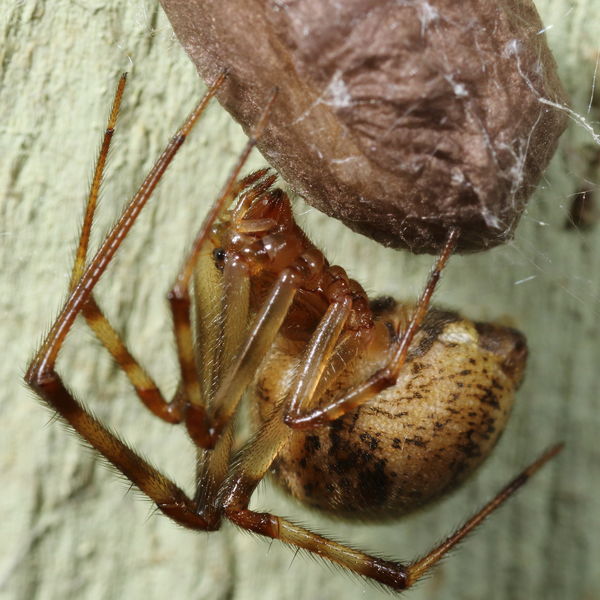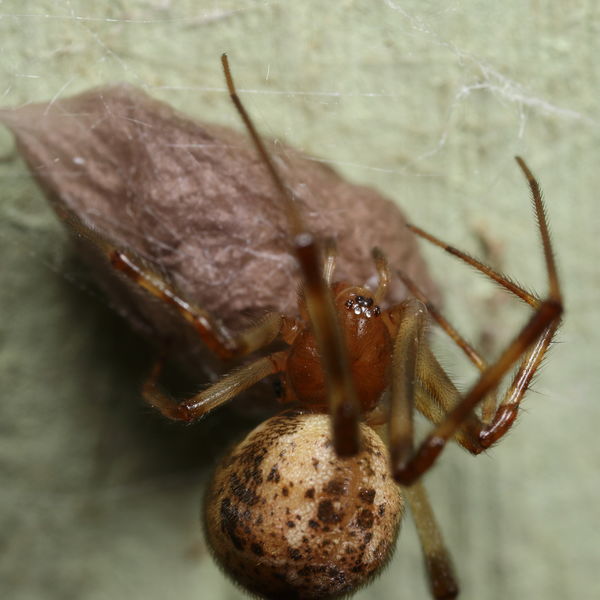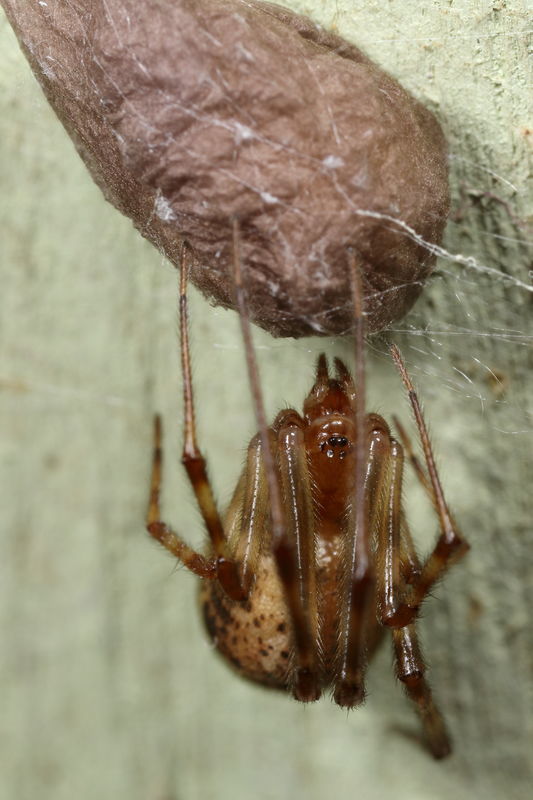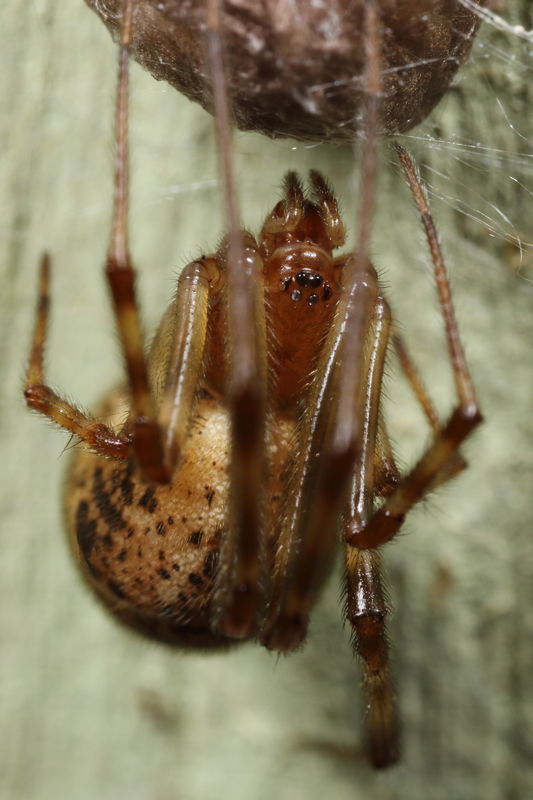Common House Spider
Nov 5, 2019 08:30:09 #
in the shed. Canon MP-E65 Comments for improvement welcomed.
Nov 5, 2019 09:12:17 #
Nov 5, 2019 09:43:29 #
Nov 5, 2019 12:06:29 #
amfoto1
Loc: San Jose, Calif. USA
Very cool shots!
The MP-E 65mm is a difficult lens to work with, but really amazing what it can do!
With greater than 1:1 magnification, depth of field gets so shallow. 1:1 is the maximum magnification most macro lenses can do. But with the MP-E 65mm it's that lens' minimum... and it goes as high as 5:1. Manual focus only, too!
I see you used f/11 for your images. f/16 is the MP-E 65mm's smallest settable aperture... But due to the way the lens extends, that setting is an "effective f/96 aperture"! Even so, there's very little DoF at full 5:1... fractions of millimeters are in sharp focus!
You have to watch out for diffraction, due the small apertures involved. I ran into that with the image below that was done with the MP-E 65mm, at about 3.5:1 and with f/16 set. This is close to f/72 "effective" aperture, due to the way the lens extends at high magnifications.

"Effective aperture" actually has more to do with exposure than with diffraction or depth of field. TTL metering with the camera is no problem and will make for reasonably accurate exposures. But if using a separate meter, perhaps with manual lighting setup, it's important to take into consideration. There are details in the user manual for the lens (avail. to download for free from Canon websites, if you don't have it).
You didn't use flash? My snail "portrait" was done with the Canon MR-14EX ring light on the MP-E 65mm, with an 8:1 lighting ratio. Personally I don't care for ring lights at lower magnifications, but it's near perfect for use with this lens!
To deal with the ultra shallow depth of field, you might experiment with "focus stacking"... For example: https://www.heliconsoft.com/heliconsoft-products/helicon-focus/ There are other software and devices for stacking, but the Helicon website has a lot of good examples illustrating it.
The multiple shots needed for stacking are difficult to impossible to do with live, moving subjects. Even that tiny snail was too quick for more than a single shot!
Some folks doing stacking use dead subjects. Interesting, but I think they tend to look "lifeless" (go figure ).
).
Another approach is to briefly refrigerate the subject so that they become immobile... then take your shots quickly before they warm back up and get active again!
If you try the refrigeration trick with any small critters... it might be a good idea to warn anyone else using the fridge!
The MP-E 65mm is a difficult lens to work with, but really amazing what it can do!
With greater than 1:1 magnification, depth of field gets so shallow. 1:1 is the maximum magnification most macro lenses can do. But with the MP-E 65mm it's that lens' minimum... and it goes as high as 5:1. Manual focus only, too!
I see you used f/11 for your images. f/16 is the MP-E 65mm's smallest settable aperture... But due to the way the lens extends, that setting is an "effective f/96 aperture"! Even so, there's very little DoF at full 5:1... fractions of millimeters are in sharp focus!
You have to watch out for diffraction, due the small apertures involved. I ran into that with the image below that was done with the MP-E 65mm, at about 3.5:1 and with f/16 set. This is close to f/72 "effective" aperture, due to the way the lens extends at high magnifications.

"Effective aperture" actually has more to do with exposure than with diffraction or depth of field. TTL metering with the camera is no problem and will make for reasonably accurate exposures. But if using a separate meter, perhaps with manual lighting setup, it's important to take into consideration. There are details in the user manual for the lens (avail. to download for free from Canon websites, if you don't have it).
You didn't use flash? My snail "portrait" was done with the Canon MR-14EX ring light on the MP-E 65mm, with an 8:1 lighting ratio. Personally I don't care for ring lights at lower magnifications, but it's near perfect for use with this lens!
To deal with the ultra shallow depth of field, you might experiment with "focus stacking"... For example: https://www.heliconsoft.com/heliconsoft-products/helicon-focus/ There are other software and devices for stacking, but the Helicon website has a lot of good examples illustrating it.
The multiple shots needed for stacking are difficult to impossible to do with live, moving subjects. Even that tiny snail was too quick for more than a single shot!
Some folks doing stacking use dead subjects. Interesting, but I think they tend to look "lifeless" (go figure
 ).
). Another approach is to briefly refrigerate the subject so that they become immobile... then take your shots quickly before they warm back up and get active again!
If you try the refrigeration trick with any small critters... it might be a good idea to warn anyone else using the fridge!

Nov 5, 2019 12:44:02 #
Nov 5, 2019 16:53:36 #
Nov 5, 2019 17:14:32 #
amfoto1 wrote:
Very cool shots! br br The MP-E 65mm is a difficu... (show quote)
Hi Alan! Thanks for the compliment! I LOVE your snail shot! I just got the MP-E65 this summer, so I am still learning how to shoot with it. Yes, DOF gets slimmer and slimmer and it's so important to get proper placement. I find manual focus is the best way for me to get proper focus -- autofocus tends to let me down half the time. I can see why the MP-E65 can be difficult trying to pinpoint focus down to fractions of a millimeter.
Yes, I did use flash for the spider images. I had diffusers on the flash -- it was a twin flash. Yes, focus stacking is definitely something I want to get into. I love attention to detail. Thanks for explaining effective aperture and the tips on diffraction and slowing down live insects -- I'll keep those things in mind.
Nov 5, 2019 18:08:59 #
Nov 6, 2019 12:36:08 #
Another winner for sure. I feel so left out for so many here appear to have a lovely variety of spiders around them all the time.
As Napabob stated, you checked all the boxes on this series of images.
As Napabob stated, you checked all the boxes on this series of images.
Nov 6, 2019 12:46:29 #
sippyjug104 wrote:
Another winner for sure. I feel so left out for so many here appear to have a lovely variety of spiders around them all the time.
As Napabob stated, you checked all the boxes on this series of images.
As Napabob stated, you checked all the boxes on this series of images.
Thank you Sippy!
If you want to reply, then register here. Registration is free and your account is created instantly, so you can post right away.








